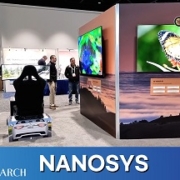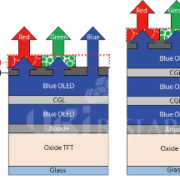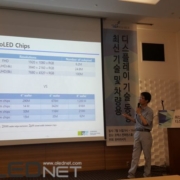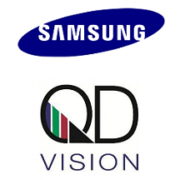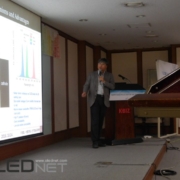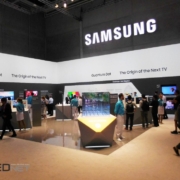Posts
BLUE OLED, is rapidly emerging as a competitor of WRGB OLED
/in Focus on /by olednetIn the premium TV market, the share of OLED TVs is steadily increasing, and the price gap with LCD is gradually decreasing. As a result, LCD TV (QD-LCD TV) companies using quantum dot technology are sluggish in the premium TV market.
OLED TV uses white OLED and OLED panel with color filter (hereafter referred to as WRGB OLED), which is mass-produced only by LG Display.
Samsung Display is known to actively develop blue OLED + QDCF (blue OLED), which is one of the technologies to compete with WRGB OLED in the premium TV market.
UBI Research predicted that Samsung Display would implement blue OLED + QDCF with top emission method and it would be more advantageous to implement 8K and BT 2020 than WRGB in its ‘2018 OLED Material Industry Report’ published on April 18.
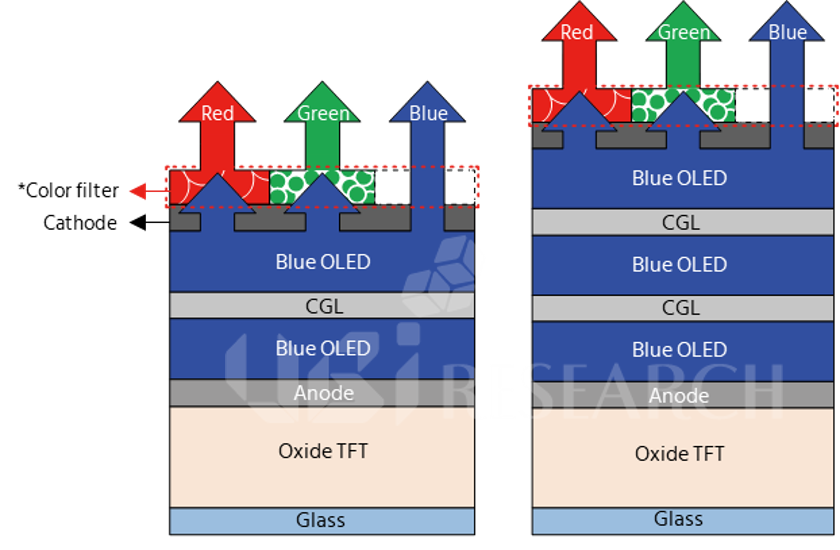
<Expected stack structure for Blue OLED, 2stack (left), 3stack (right), 2018 AMOLED emitting materials Report, UBI Research>
8K and BT2020 are to be adopted for the premium TVs. Also, the development of blue materials is expected to be aggressively progressed according to Samsung Display’s development of blue OLED. The blue material currently used in OLED is a fluorescent material that is insufficient in the efficiency and lifetime than phosphorescent material used in red and green. Blue phosphorescent materials have been developed continuously but they have not been applied to mass production due to the scarcity of materials and technical barriers. Therefore, blue fluorescent materials are stacked two or more times to improve efficiency and lifetime for large area OLED, and blue OLED is expected to use more than 2 stack structure.
With this trend, the market for blue emitting materials is expected to continue to grow. In 2017, blue materials (host and dopant) formed market of US$ 70 million. According to the 2018 AMOLED emitting material market track published by UBI Research, blue material is expected to grow at an average annual rate of 32% by 2022 and reach US $ 272 million sales.
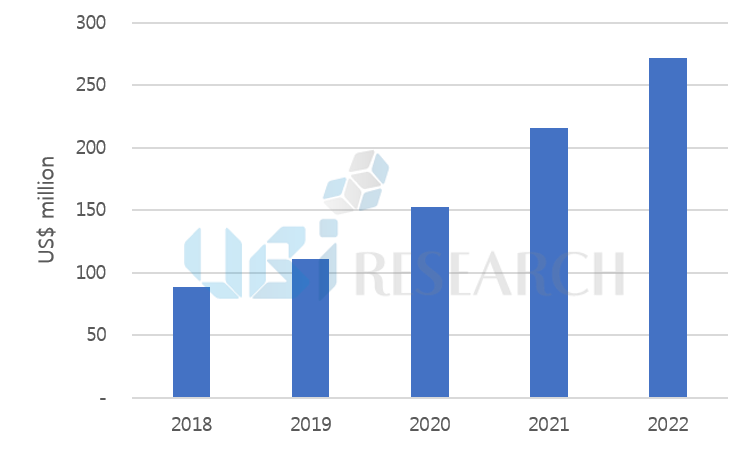
<Blue material (host and dopant) market forecast, 2018 AMOLED emitting materials Market track>
Can BLUE OLED be used for OLED TV?
/in /by olednetSamsung Display selected blue OLED + QDCF (blue OLED) as next generation display technology following LCD TV, and started the necessary development.
Blue OLED is a technology, in which blue light emitted from blue OLED passes through a quantum dot color filter to represent red and green colors (b). The WRGB OLED used in OLED TV is a method in which white light passes through a color filter and implements RGB colors (a).
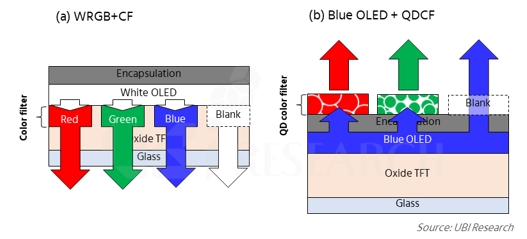
The ‘2018 OLED Materials Industry Report’ published by UBI Research on April 18 describes whether blue OLED, which Samsung Display has started to develop, can become TV OLED panels. The expected development direction and performance (efficiency and lifetime) of blue OLED + QDCF are analyzed. In particular, current status and development trends (fluorescence, phosphorescence, TADF) of blue emitting material, which is the core material of blue OLED, are covered.
Since blue OLED of Samsung Display is top emission type, the aperture ratio is increased by about 70% compared to the bottom emission, which emits light in the TFT direction, so that 8K resolution and high brightness are realized better than the conventional WRGB OLED. In addition, it is expected to reach BT. 2020, the UHD color standard, which was established by the International Telecommunication Union (ITU) in 2012, using QD material with high color reproduction rate as color filter.
In the future premium TV market, 8K and BT. 2020 are necessary conditions for display. WRGB OLED is also being actively developed to implement 8K and BT2020. Attention is focused on the impact of the development of blue OLED in the premium TV market led by WRGB OLED.
In addition, the report analyzes the market status and development trends of the related companies, including overall technology development directions and key issues for new materials such as soluble OLED materials and near IR materials.
QD-OLED TV, is it to be the next generation premium TV?
/in Focus on, Focus on, Focus on, Focus on, Focus on, Focus on, Focus on, Focus on, Focus on, Technology /by olednetSamsung Electronics is currently occupying the premium TV market with QD-LCD TVs, which use ‘PL-QD (photoluminescence quantum dot) technology’. This technology has a mechanism in which the material stimulated by external light re-emits light.
The operating profit of the consumer electronics division (CE), which controls QD-LCD TVs, fell more than Korean won 1 trillion in last year and the operating profit ratio was only 3.6%.
On the other hand, LG Electronics’ HE business division achieved a record operating profit of Korean won 1,566.7 billion and an operating margin of 8.1% through OLED TV. Sony also turned its operating profit into a surplus by quickly taking over the premium TV market with OLED TV.
OLED TV has had a positive effect in driving corporate sales growth.
Samsung Electronics has been developing EL-QLED, with EL-QD (electroluminescence quantum dot) technology, to increase its market share in the premium TV market. However, efficacy, lifetime and mass production technology of quantum dot, which is the material of QLED, is not yet secured.
Recently, QD-OLED TV technology, which uses blue OLED as a light source and that implements red and green colors through a quantum dot color filter (QDCF), is attracting attention.
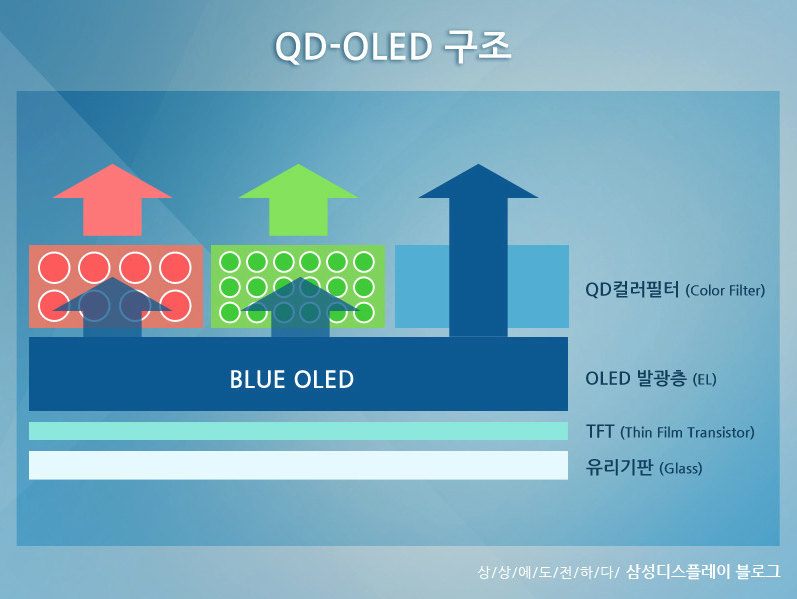
<Expected structure for QD-OLED, Source: Samsung Display Blog>
By using QDCF, it is possible to easily make desired colors by adjusting the size of the QD material and improve the color reproduction rate. This is because the color gamut is enlarged to BT2020, so it is close to natural color and it is possible to deliver vivid picture quality more clearly. In addition, QD-OLED TV has a top emission structure, which makes it easy to secure the aperture ratio, thereby improving resolution and screen uniformity.
However, in QD-OLED TV, there are various problems to be solved such as lifetime and efficiency of blue OLED, and technology of ink-jet printing process. Given that the industry is still in the early stages of reviewing the business possibility, QD-OLED TVs are expected to go into mass production after 2020.
Attention is focused on the QD-OLED TV’s entry into the premium TV market and its impact.
What is the next-generation display poised to outshine OLED?
/in Display, Display, Display, Display, Display, Display, Display, Display /by olednetThe micro LED, QLED and hologram, which are referred to as the next generation displays, were presented at the seminar entitled ‘Recent Trends in Display and Vehicle Display Technology’ hosted by UBI Research on the 14th.
Under the theme ‘Technical Issues of micro LED Display and Market Trend’, professor Moon Dae-gyu of Soonchunhyang University said, “Micro LED can be realized in high resolution and it is easy to implement curved display or flexible display because there is no limit of panel shape and size” He added “When applying micro LED to a display, high resolution is feasible even on a small substrate size, so that it can be applied to VR, etc.” and expected “When applied to a public display, it will be able to escape from the method of tiling many display panels”. However, there remain some technical problems such as the problem of transferring and connecting millions of LED chips quickly and accurately, the deviation problem of color and luminous efficiency between LED chips, and the technical problem of implementing an active matrix for the application of a display.
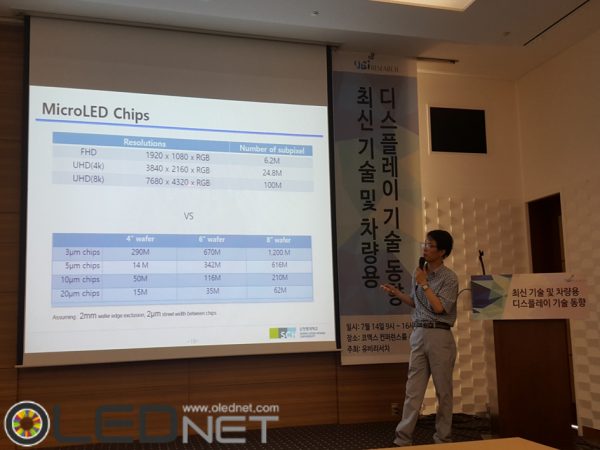
<Professor Moon Dae-gyu of Soonchunhyang University>
Next, Dr. Hwang Do-Kyung of Korea Institute of Science and Technology(KIST), Dr. Bae Wan-ki, senior researcher of KIST, and Dr. Oh Min-Suk of Korea Electronics Technology Institute(KETI) announced the manufacturing principle of quantum dot and the possibility of self-emitting QLED using it. Dr. Hwang said, “The quantum dot has the advantage of not only color change depending on the size and but also narrow half width.” “Self-emitting QLED can display higher color purity than OLED.” he added.
Dr. Bae expected “If research is carried out on an enterprise scale, the speed of technology development will increase more rapidly.” saying that “At present, the efficiency of quantum dot devices is continuously improving, but the life span is insufficient compared to OLED.”
“We need the next generation display technology to follow the LCD and OLED,” said Dr. Oh Min-Seok of Korea Electronics Technology Institute(KETI). He added “QLED is attracting much attention as a next-generation display, but there remain such issues as too much focus on the development of emitting devices, the lack of solution process-related devices and technologies, and the non-cadmium-based high-efficiency blue light emitting devices”.
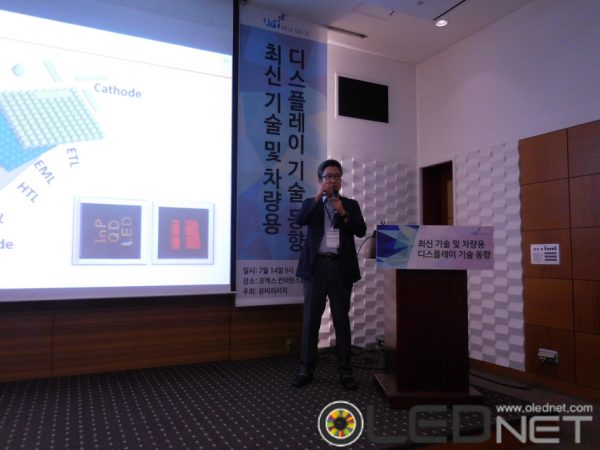
<Dr. Oh Min-Seok of Korea Electronics Technology Institute(KETI)>
As the last speaker, Kang, Hoon-Jong, team leader of Korea Electronics Technology Institute(KETI) explained the digital hologram technology and its application, and emphasized that a display panel capable of expressing the hologram is necessary to implement it. He said “We have a holographic printer or a microscope but there is no enough technology to apply it to TV”. Then, he closed his presentation saying “We need to develop a film for hologram first and then a functional design that can implement the screen.”
During the presentation about the next generation display, many of the speakers emphasized the importance of cooperation and participation among schools, research institutes and companies in order to overcome technical problems and realize them as actual displays. The display competition is expected to become even more intense in the future, as R&D in micro OLED, QLED, and hologram, which are considered as the next generation display, is concentrated.
Would it be possible to accelerate commercialization of QLED by Samsung Electronics’ acquisition of ‘QD Vision’?
/in /by olednetAccording to the industry source dated Nov. 21, it was confirmed that Samsung Electronics was selected as a preferred bidder participating in the acquisition battle for ‘QD Vision’. The amount of acquisition proposed by Samsung Electronics is U$70million, and the industry expects that the final takeover will be agreed no later than the next week.
Quantum dot is the materials whose implementing color is different according to the size, and Samsung Electronics is introducing SUHD TV to the premium TV market, which improves the color reproduction rate by applying quantum dot sheet to LCD BLU for the first time in the world, and Chinese companies are actively launching the products.
‘QD Vision’ established by the researchers from MIT, is a specialized enterprise with high technology in the field of cadmium-based quantum dot and it is introducing non-cadmium-based material, too, lately. The industry considers that the acquisition of ‘QD vision’ by Samsung Electronics is the cornerstone to accelerate the commercialization of QLED along with the expansion of the quantum-dot TV market.
Although QLED is highly anticipated to be available to realize the panel with high purity as it is less impacted by oxygen and moisture than OLED and as it has a narrow half width, very low efficiency and life time compared to OLED materials are mentioned as the problem, under its initial stage of development. Furthermore, cadmium used in the core of quantum dot is highly toxic carcinogen, so Cd-free materials are being developed by ‘QD Vision’, ‘Nanoco’, ‘Nanosquare’, etc., however, its performance is lower than Cd-base materials. Therefore, the industry expects that it will take at least 5 years for QLED to be applied to mass production.
In the meantime, related with this issue, in the ‘Market penetration possibility analysis and seminar for QLED and Solution Process OLED’ hosted by UB Research in last October, Professor Chang-hee Lee of Seoul National University mentioned that, “If large-scale investment and manpower would be input, it is likely to find the product in earlier time than expected, and there is a possibility that the entry barrier can be lowered due to its similar structure to OLED”
It is highly attended that whether the acquisition of ‘QD vision’ by Samsung Electronics can accelerate the commercialization of QLED by becoming the starting point of large-scale investment, and what effect would be influenced to the display industry.
Aggressive investment on QLED, Shortcut of OLED commercialization
/in Display /by olednetAt ‘an analytical seminar on market entry potential of OLED and Solution Process OLED’ having been held in Seoul Small& Medium Business Center on last October 14th, Professor Lee Chang-hee of Seoul National University and Senior Researcher Bang Ji-won of Korea Institute of Ceramic Engineering and Technology shared opinions about current situations of QLED, development trends, and issues.
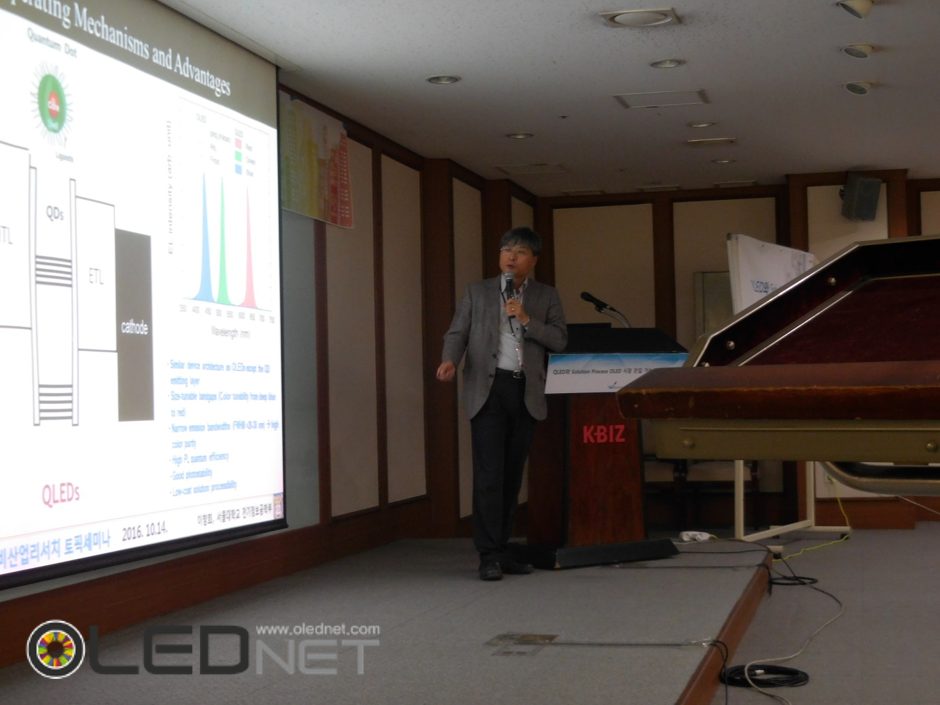
<Professor Lee Chang-hee of Seoul National University>
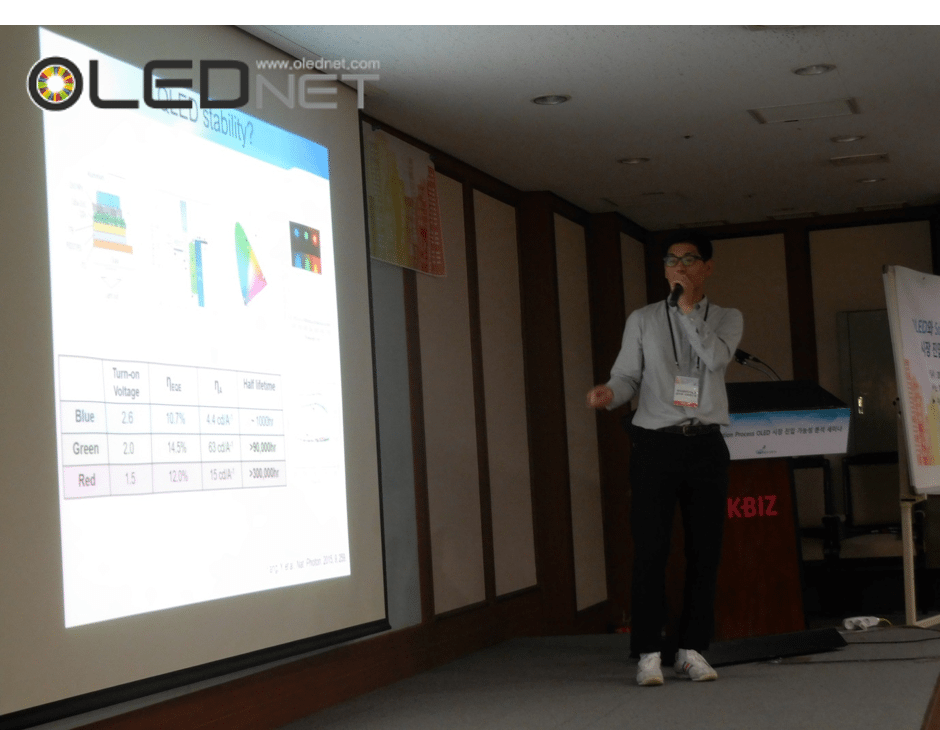
<Senior Researcher Bang Ji-won of Korea Institute of Ceramic Engineering and Technology>
Professor Lee Chang-hee said that QLED had excellent color purity because half-width of QLED was narrower than OLED by approximately 20~30nm, and disclosed a fact that QLED was favorable in color reproduction due to high levels of accuracy when manufacturing it, and efficiency of luminescence material reached to regular levels to the degree of catching up OLED. However, he stated technical difficulties of Cd-free QLED which did not use cadmium, a heavy metal, together with securing life stability of QD (Quantum Dot) luminescence materials, and emphasized that investment on QLED is the shortcut of commercialization by saying “The time of commercialization could be moved forward to 5 years or 3 years according to capital and manpower investing scales from the industry.”
Senior Researcher Bang Ji-won pronounced luminescence efficiency of light-emitting materials, stability, non-toxic QD, and approaches by various directions such as QD-LCD which applied QD CCL (Color Change Layer) to blue-LED BLU (Black Light Unit) by using QD, OLED which applied OD-CCL and C/F (Color Filter) to WOLED, OLED that applied QD CCL without C/F to blue-OLED were being progressed.
QLED-related academia discussed about the potential of OLED positively in this way, but CEO Lee Chung-hoon of UBi RESEARCH said “Development of WOLED will be strived too because QLED has already been developed, and if brightness is more enhanced after being evolved to top emission method from current bottom emission one, QLED entry to premium market will become difficult further, and then pronounced “When new technology can enter the market, considerations whether new technology will be good from certain aspects including performance, efficiency, cost etc. shall be made in case of comparing them with the technologies having been commercialized ”
Possibility for market entry of Solution process OLED and QLED with new technology of large surface.
/in /by olednetCurrently in the market of premium TV, OLED TV and QD- LCD industries are highly competitive.
QD vision with Nanosis and SID 2016 and IFA 2016 also emphasized quality of TV with QD material included comparing quality of OLED TV. Against this, LG Display joined the completion by emphasizing quality of OLED TV as an ideal display for HDR with comparison between QD-LCD and OLED in IFA 2016 with from SID 2016,
In current large surfaced TV market, LCD TV is taking overwhelmingly large share in distributed market while OLED TV gradually is growing large share in premium market.
In looking into strategies of each industry, large surfaced OLED is developing solution process OLED in order to achieve broader market share with from premium model to distributed model. To overcome weakness compared to OLED, LCD TV industry progressively use QD material with the final goal of development of QLED technology
As a competition in premium TV market gradually extends to entire area of TV market, present condition and possibility of market entry with solution process OLED and QLED is one of major interest.
For this matter, there is seminar host by Ubi Industrial Research with the theme of “analysis in possibility of market entry with QLED and Solution process OLED” in Medium sized business center, Yeouido, October 14th and will be discussing present market industry of large surfaced TV and panel and also will be dealing with present condition and issue of QLED and Solution process OLED, and future possibility of market entry.
Choong-Hoon Lee, president of Ubi Industrial Research, will suggest future direction of OLED industry with analysis of present condition and possibility of market entry in OLED and QLED.
Sung-Jin Jung, head of department of Du Pont, will be discussing the timing of market entry of solution process OLED with the demonstration of soluble OLED material, the essential part of solution process OLED, including present trend and up to date developmental technique
Professor Chang-Hee Lee and senior researcher Ji-won Bang from Korean Institute of Ceramic Engineering and Technology(KICET) will be discussing about advantage and developmental issue of Quantum dot material and direction of future development.
The seminar attracts attention in terms of providing an opportunity to share and discuss regarding issue through media and exhibition with technological and market perspectives of Ubi Industrial Research and share opinions and future possibility.
For registration and any inquiry, please contact to Hana Oh (hanaoh@ubiresearch.co.kr, 02 577 4940) from Ubi Industrial Research.
[OLED summit 2016]OLED TV vs. QLED TV, OLED TV black expression overpower
/in /by olednetIn OLED Summit 2016 being held in San Diego, USA, LG Display compared similar level of highest model 65-inch LG UHD OLED TV and 65-inch Curved QD-LCD TV, which it attracted many participants’ attention.
The specification of comparing models are as follow.
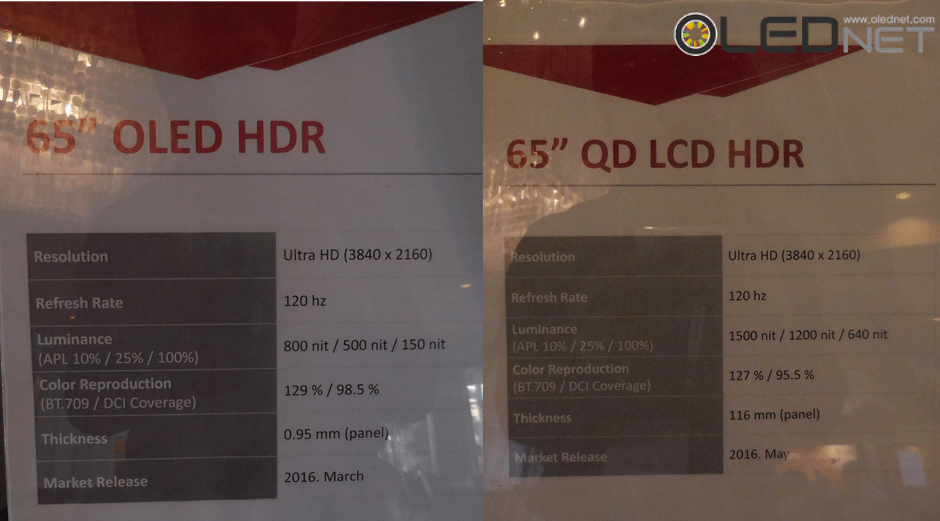
It presented in a way to compare various picture qualities of OLED TV and QD-LCD TV through various films and patterns such as normal TV program and movies.
LG Display personnel said, “OLED TV absolutely expresses black better than QD-LCD TV if OLED TV and QD-LCD TV set the mode that expresses white color 6500K which is the standard of UHD Alliance. Basically, the brightness of QD LCD TV is higher than OLED TV, but because the basis is LCD, it feels more distortion because of more white tone compared to the color of OLED TV. Also, OLED TV can almost express without distortion even in viewing angle, but the color is distorted in QD-LCD”, emphasizing better quality of OLED TV than QD-LCD TV.
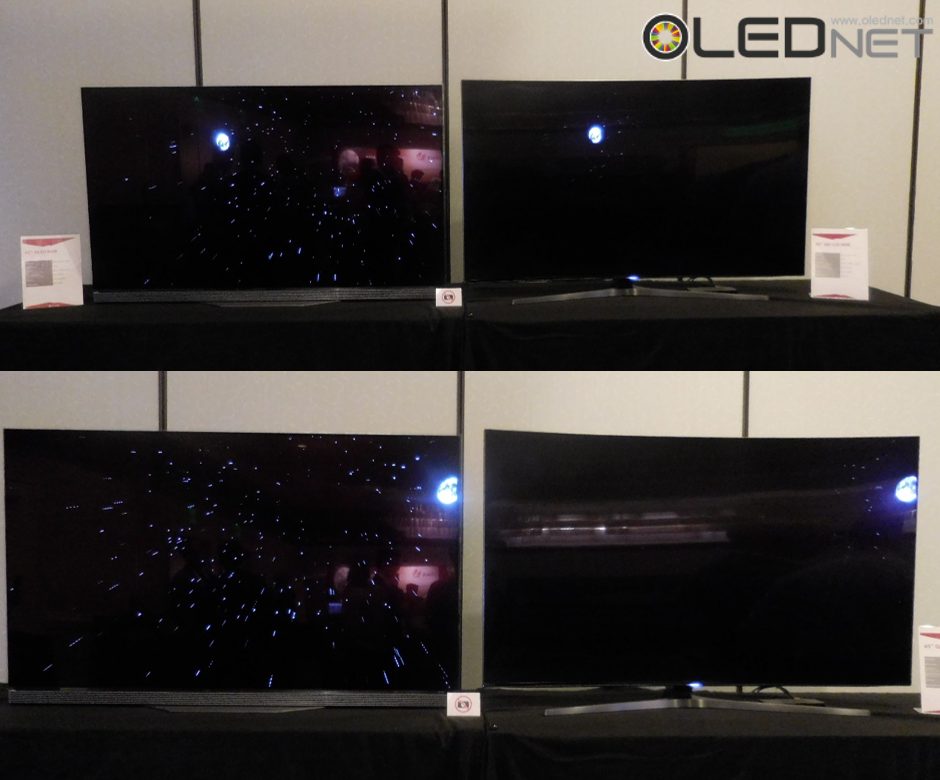
< Comparisons of 65inch OLED TV(Left) and 65inch curved QD-LCD TV’s Black Expressiveness >
Comparing the two pictures similar to images of space show below at the exhibition, OLED TV shows individual stars accurately while QD-LCD TV presents the stars vaguely just to indicate them. In the aspects of viewing angle, OLED TV nearly didn’t have any left-right color changes but its changes were found in QD-LCD TV.
Previous SID2016’s Nanosis and QD vision, Samsung and Hisense emphasized that QD-LCD is better than OLED TV in IFA 2016, but in this OLED Summit 2016, LG Display showed that OLED TV is much more outstanding compared to QD-LCD TV.
Like this, the position between QD-LCD TV and OLED TV is becoming more competitive, and the industry has the interest in which type of TV will gain more of customer’s trust.
[IFA2016] What is the exhibition concept of Samsung Electronics TV?
/in /by olednetSamsung Electronics TV Booth displayed in IFA2016 is very different from before. There are two types of LCD TVs in the market currently: the existing TV using LED BLU, and SUHD TV that uses quantum dot sheet. However, the product that was introduced and occupied a lot of booth exhibition space was the inorganic TV that uses quantum dot display, a product with unclear release date.
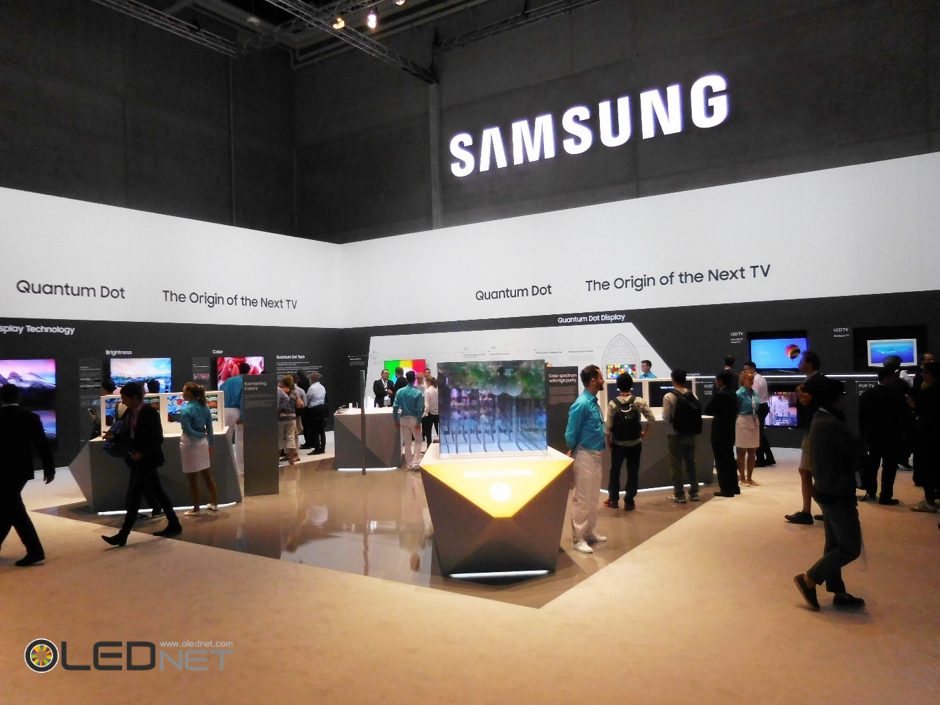
The conceptual inorganic TV that Samsung Electronics introduced instead of actual TV product is a product that displays far superior performance to OLED TV. As time goes by, the “organic” that represents OLED TV loses its function as a TV due to its rapidly decreasing brightness, whereas “inorganic” does not undergo such changes. If this is true, it is an excellent product that may well be used forever.
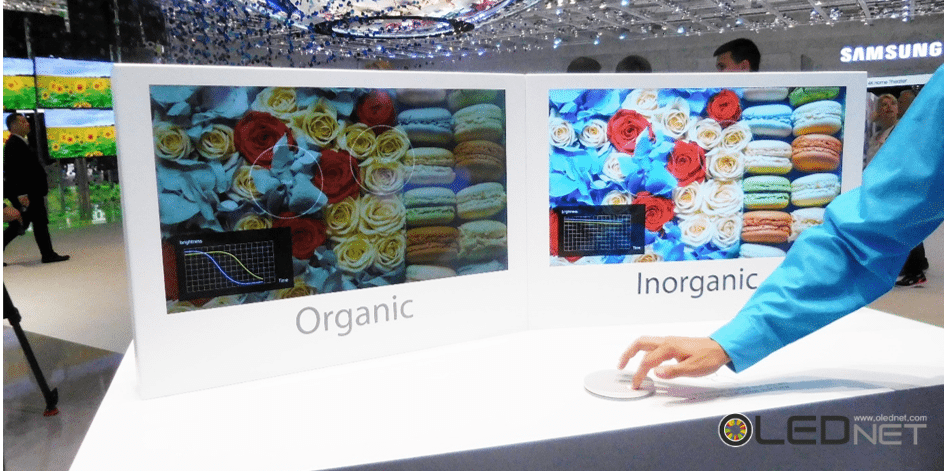
In another concept exhibition, Samsung Electronics introduced the superior color purity of Inorganic TV.
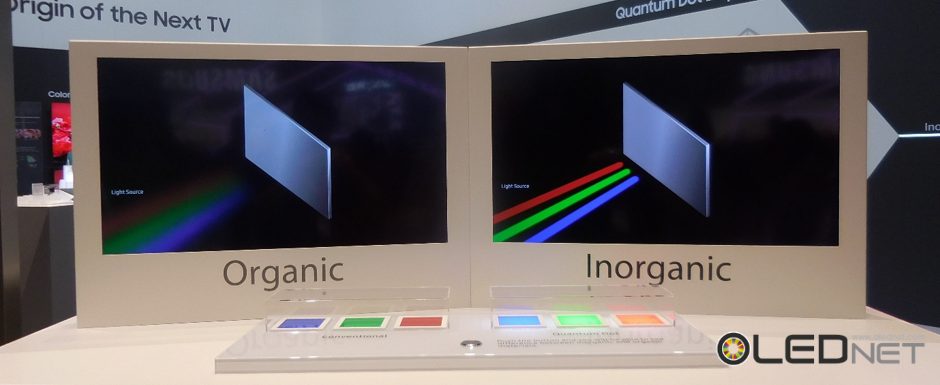
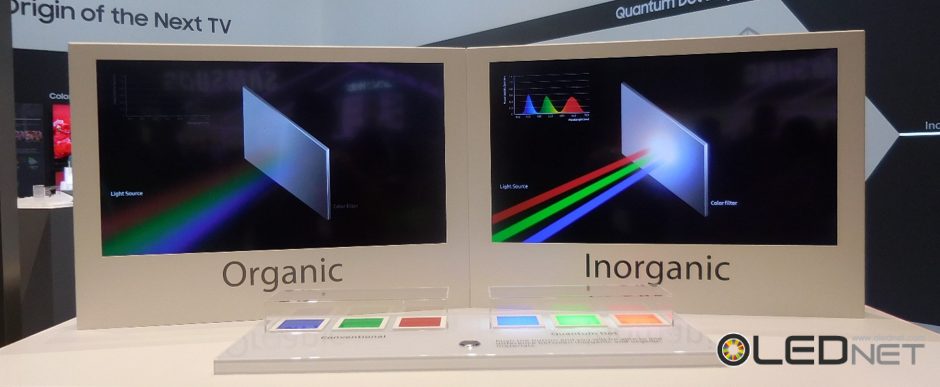
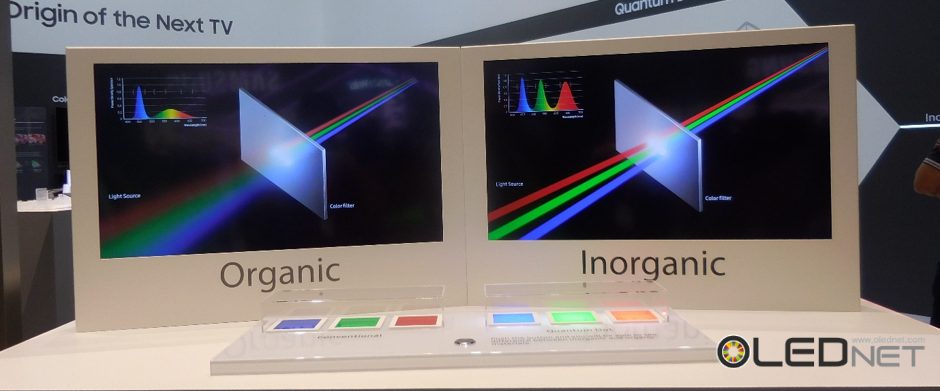
The light coming from the Organic TV light source has very vague RGB. In contrast, inorganic TV originates from clear RGB. Inorganic creates independent wavelength and intensity even before this light arrives at the color filter, whereas organic still displays a vague light with separated color.
The structure of inorganic TV seen from this is assumed to be a form in which a quantum dot substance is inserted between the screen and the color filter.
Finally, the light of organic, which goes through the color filter, lacks color purity of the three primary colors because it converts two-wavelength light with blue and green-red to three-wavelength.
However, even before arriving at the color filter, the light with superior color purity is emitted outside in inorganic.
If these two exhibitions are true, Samsung Electronics is preparing an incredible next-generation TV.
The problem pointed out by the participants is that this technology has not been born yet, and it is merely a concept. Samsung Electronics has described the unknown world with confidence, which is ironically viewed as if they are utterly unprepared for the future TV.
Moreover, by comparing OLED TV with a TV technology of the future instead of the SUHD TV currently in the market, they have indirectly admitted that OLED TV is better than the SUHD TV that uses quantum dot.
In IFA2016, Samsung Electronics wanted to show that SUHD TV will continue to grow and that OLED TV will disappear eventually. However, they have admitted that they are in an urgent situation in which, due to the superiority of OLED TV to the current SUHD TV, it cannot avoid being compared to the inorganic TV of the future.
Finally, whatever is done to LCD TV, black should be avoided, because it is LCD.
Samsung, announced the availability and pricing for New SUHD TVs
/0 Comments/in /by OLEDNET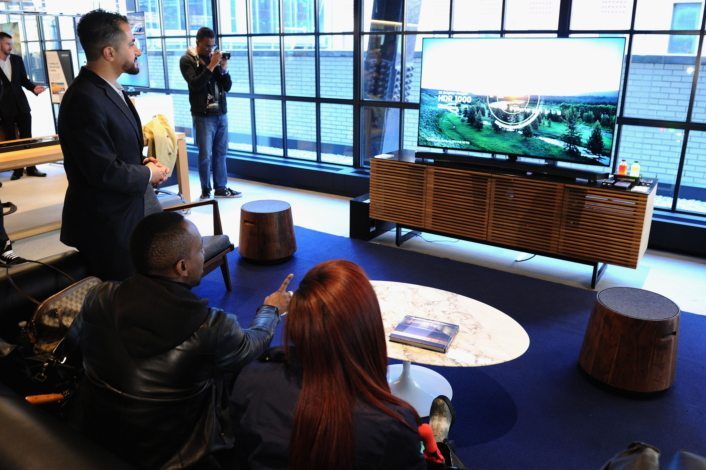
Samsung Electronics America, announced the availability and pricing for its 2016 line up, including SUHD TVs.(Source=Samsung Elec.)
Samsung Electronics America, the leader in home entertainment for over 10 years, announced the availability and pricing for its 2016 line up, including an entirely new Flagship model series – the KS9800, bringing a new meaning to Smart TV.
“Samsung has always been about the ultimate experience in Picture Quality. This year is no different. Our new SUHD models provide the brightest, most realistic color and clarity for every viewing environment,” said Dave Das, Senior Vice President, Samsung Electronics America. “What is new this year is our redefined Smart TV experience. We listened to our customers and made enjoying content the easiest it’s ever been”
Whether it’s SUHD, UHD or LED, Samsung delivers the brightest, most stunning picture quality, with richer colors and more dynamic audio than ever before.
Samsung’s SUHD TVs feature the world’s only cadmium-free 10 bit Quantum Dot Display, setting the quality standard of 1,000-nit HDR with the best and most vibrant color and contrast available for true-to-life picture and experience. The Ultra Black feature reduces reflections by absorbing light to help provide for deeper, richer blacks. This year’s Samsung SUHD line up meets the UHD-A’s Premium UHD certification program, which ensures consumers are getting the most premium experience from their UHD TV.
From curved and slim to the new boundless design edge, Samsung offers stunning design with optimum viewing. The new KS9500 features an immersive ‘360’ design that is elegant and looks beautiful from every angle.
Samsung’s 2016 Smart Hub Interface takes simplicity to the next level. The new Smart Hub Interface eliminates a lengthy setup process by automatically integrating set top boxes from cable providers like Time Warner, Comcast (coming soon), and satellite services such as DIRECTV (coming in June), as well as game consoles. Users can simply plug the STB into any HDMI port, and the TV will recognize the box and provider, as well as automatically set up the remote control to access and control the STB features – not just channel up and down, but DVR controls and other commonly used controls – without the user ever having to program or “teach” the remote. It’s the ultimate in simplicity.
The UBD-K8500 supports backward compatibility, upscaling existing 3D Blu Ray, Blu Ray to near-UHD quality. The player can also handle the next generation of home audio formats, including immersive, object-based sound formats like Dolby Atmos and multi-channel systems.
For 2016, Samsung offers breathtaking design and unparalleled excellence with its new line of TVs, including a series of five Curved SUHD TVs and a series of five UHD TVs that vary in display size from 49” to 88”. Ranging from the popular curved form to the traditional flat-panel, Samsung provides consumers with sleek appeal, the most exceptional picture quality and smartest TVs.
The Samsung KS9800 SUHD TV will be available in early June in a 65” model for $4,499, and an 88” model for $19,999. A 78” model will be available in early May for $9,999.
The Samsung KS9500 Curved SUHD TV is available now in a 55” model for $2,499 and a 65” model for $3,699. A 78” model will be available in early June for $7,999.
Samsung’s KS9000 4K SUHD TV is available now in a 55” model for $2,299, and a 65” model for $3,499. A 75” model will be available in early June for $6,499.
Samsung’s KS8500 4K SUHD Curved TV is now available now in a 55” model for $1,999 and 65” model for $2,999. A 49” model will be available in May for $1,699.
The Samsung KS8000 is now available in a 55” model for $1, 799, and in a 65” model for $2,799. Starting in May, it will be available in a 49” model for $1,499, and a 60” model for $2,299.
영문 풋터
UBI RESEARCH / CEO:Choong Hoon Yi / Business License Registration Number 220-87-44660
ADDRESS: A-1901, Samho Moolsan Bldg, 83, Nonhyeon-ro, Seocho-gu, Seoul, Republic of Korea (Zip) 06775 TEL:+82-2-577-4390 / E-MAIL:marketing@ubiresearch.com

